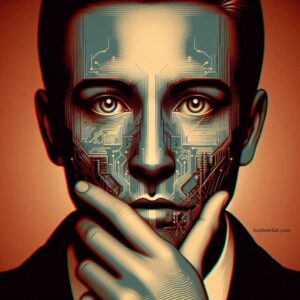What is Deepfake?
Deepfake Technology refers to a technique that uses artificial intelligence (AI) to create or manipulate video, audio, or images to make them appear authentic but are actually fabricated or altered. The term is derived from “deep learning” and “fake.” Deep learning algorithms, particularly those based on neural networks, are used to analyze and manipulate data, allowing for the creation of convincing fake content.
Initially, this technology gained attention for its ability to swap faces in videos, often used for humorous or entertainment purposes. However, it has raised significant concerns due to its potential for misuse, such as creating deceptive political propaganda, spreading false information, or generating explicit content featuring individuals without their consent.

As a result, there have been efforts to develop countermeasures to detect and mitigate the spread of Deepfake content, as well as legislative initiatives to address its potential harms. However, the technology continues to advance, making it increasingly challenging to distinguish between authentic and manipulated media.
This technology has evolved rapidly since its inception, driven primarily by advancements in artificial intelligence, particularly in the field of deep learning.
Here’s a brief overview of its evolution:
- Face swapping: initially gained attention for its ability to swap faces in videos seamlessly. Early iterations relied on deep learning techniques to map and superimpose one person’s face onto another’s, creating convincing but fake videos.
- Generative Adversarial Networks (GANs): The development of GANs, a type of neural network architecture consisting of two networks— a generator and a discriminator— accelerated the progress of the technology. GANs enable the generation of highly realistic images and videos by pitting two neural networks against each other, with one generating fake content and the other discerning between real and fake, leading to iterative improvements in the generated content.
- Improved realism and sophistication: Over time, its algorithms became more sophisticated, enabling finer manipulation of facial expressions, movements, and speech. This increased realism made it more challenging to detect manipulated content, as it closely resembled authentic footage.
- Expansion beyond faces: While this technology initially focused on manipulating faces, it has since expanded to other forms of media manipulation, including voice synthesis, where AI algorithms can mimic a person’s voice with remarkable accuracy. This expansion broadened the potential applications and implications of Deepfake technology.
- Accessibility: As its algorithms became more refined, the tools and software necessary to create Deepfake content became more accessible to a wider range of users. This accessibility facilitated the proliferation of Deep-fake content across various online platforms.
- Countermeasures and regulation: The increasing prevalence of deepfake content has prompted efforts to develop countermeasures, such as deepfake detection algorithms and digital watermarking techniques. Additionally, there have been calls for regulatory measures to address the potential risks associated with deepfake technology, including the dissemination of false information and the violation of privacy rights.
Here are some lesser-known aspects and implications of Deepfake technology:
- Audio Deepfakes: While much attention has been focused on visual Deepfakes, audio Deepfakes are also a significant concern. AI algorithms can manipulate audio recordings to create synthetic voices that sound convincingly like real people. This raises concerns about the potential for voice impersonation, identity theft, and the spread of false information through audio channels.
- Synthetic Text: Deep learning algorithms can also generate synthetic text, mimicking the writing style of specific individuals or even generating entirely fabricated articles or messages. This raises concerns about the proliferation of fake news, misinformation, and the erosion of trust in written content.
- Potential Positive Applications: While deepfake technology has been predominantly associated with negative applications such as misinformation and fraud, there are also potential positive applications. For example, it can be used for entertainment purposes, such as creating realistic special effects in movies or video games. Additionally, it can facilitate historical and cultural preservation by digitally reconstructing damaged or lost audiovisual material.

- Digital Privacy Concerns: Deepfake technology poses significant threats to personal privacy, as it can be used to create highly realistic fake videos and images featuring individuals without their consent. This raises concerns about the potential for harassment, defamation, and the exploitation of individuals for malicious purposes.
- Implications for Journalism and Media: The proliferation of deepfake technology has implications for journalism and media integrity. It becomes increasingly challenging to verify the authenticity of digital content, leading to concerns about the spread of misinformation and the erosion of trust in media sources.
- Forensic Challenges: Detecting deepfake content presents significant forensic challenges. Traditional methods of digital forensics may be insufficient to detect sophisticated deepfake manipulations. Researchers are developing specialized algorithms and techniques to identify inconsistencies and artifacts indicative of deepfake manipulation.
- Ethical Considerations: Deepfake technology raises complex ethical considerations regarding consent, authenticity, and the manipulation of digital content. There is a need for ethical guidelines and standards to govern the responsible development and use of deepfake technology.
- Legal and Regulatory Responses: Governments and policymakers are grappling with the need for legal and regulatory responses to address the potential harms associated with deepfake technology. This includes considering legislation related to privacy rights, defamation, intellectual property, and the regulation of synthetic media.
Understanding these various aspects of deepfake technology is crucial for navigating its implications and developing strategies to mitigate its potential risks while harnessing its positive potential.
Overall, deepfake technology has evolved from a niche research area to a widely accessible and potentially disruptive tool, posing both challenges and opportunities for society, technology, and policy development.
How and When Deepfake evolve?
Deepfake technology evolved primarily through advancements in machine learning, particularly in the field of deep learning, which is a subset of artificial intelligence. While the concept of digitally altering images and videos has been around for decades, the term “deepfake” specifically refers to the use of deep learning algorithms to create highly realistic synthetic media.
Here’s a timeline highlighting key developments in the evolution of deepfake technology:

- Early 2010s: Deep learning techniques, particularly convolutional neural networks (CNNs), began to gain traction in computer vision research. Researchers explored the use of CNNs for tasks such as image recognition and classification.
- Late 2010s: Researchers and developers began experimenting with applying GANs and other deep learning techniques to manipulate images and videos. The term “deepfake” gained popularity, particularly with the emergence of online communities and platforms dedicated to sharing deepfake content.
- 2014-2015: Academic research on generative models, particularly Generative Adversarial Networks (GANs), started gaining attention. GANs, introduced by Ian Goodfellow and his colleagues in 2014, became a breakthrough in generative modeling, allowing for the creation of realistic synthetic data, including images and videos.
- 2017: Deepfake technology garnered widespread attention with the release of highly realistic fake videos featuring celebrities and political figures. These videos showcased the potential of deepfake technology to create convincing but fabricated content.
- 2018: Concerns about the misuse of deepfake technology, including its potential to spread misinformation, manipulate elections, and violate privacy rights, started to escalate. Researchers and policymakers began exploring ways to detect and mitigate the impact of deepfake content.
- 2019-Present: Deepfake technology continued to evolve rapidly, with improvements in realism, sophistication, and accessibility. Researchers developed more advanced deep learning algorithms capable of generating highly convincing synthetic media, including not only facial swaps but also voice synthesis and full-body manipulation.
- Countermeasures and regulation: Efforts to develop countermeasures to detect and mitigate deepfake content intensified. This included the development of deepfake detection algorithms, digital forensics techniques, and media literacy initiatives. Additionally, policymakers around the world began considering regulatory measures to address the potential risks associated with deepfake technology.
Throughout its evolution, deepfake technology has raised important ethical, legal, and societal questions, highlighting the need for a multi-faceted approach involving technology development, regulation, and public awareness efforts.
How Deepfake can be used?
Deepfake technology can be used in various ways, both positive and negative. Here are some examples of how deepfake technology can be used:
- Entertainment and Media Production: Deepfake technology can be used to create realistic special effects in movies, television shows, and video games. It allows filmmakers to digitally recreate historical figures, bring fictional characters to life, or enhance scenes with complex visual effects.
- Dubbing and Localization: This technology can facilitate the dubbing and localization of content by automatically synchronizing lip movements with translated dialogue. This can streamline the process of adapting content for international audiences while maintaining a high level of realism.
- Digital Avatars and Virtual Influencers: Deepfake technology can be used to create lifelike digital avatars and virtual influencers. These digital personas can interact with audiences on social media, promote products and brands, and even serve as spokespeople for organizations.
- Personalized Content Creation: This technology can enable the creation of personalized content, such as personalized video messages or greetings featuring celebrities or fictional characters. This can enhance user engagement and create unique experiences for audiences.
- Historical and Cultural Preservation: Deepfake technology can be used to digitally reconstruct damaged or lost audiovisual material, preserving historical and cultural heritage for future generations. It can restore and enhance archival footage, photographs, and recordings, allowing them to be experienced in new ways.
However, deepfake technology also has negative potential uses:
- Misinformation and Fake News: Deepfake technology can be used to create highly realistic fake videos and audio recordings, making it difficult to discern between authentic and manipulated content. This raises concerns about the spread of misinformation, fake news, and the manipulation of public opinion.
- Identity Theft and Fraud: Deepfake technology can be used for identity theft and fraud by creating fake videos or audio recordings impersonating individuals. This can be used for financial scams, extortion, or reputational damage.
- Political Manipulation: This technology can be used for political manipulation, such as creating fake videos or audio recordings to discredit political opponents, spread propaganda, or influence elections. This poses risks to the integrity of democratic processes and public trust in political institutions.
- Privacy Violations: The technology can be used to create fake videos or audio recordings featuring individuals without their consent, violating their privacy rights and potentially causing reputational harm.
While this technology has positive potential uses, it also raises significant ethical, legal, and societal concerns that need to be addressed through responsible development, regulation, and public awareness efforts.
Does Deep fake technology have bright future, or it will die facing rules and regulations or legality?
The future of this technology is likely to be influenced by a combination of factors, including technological advancements, regulatory measures, societal attitudes, and ethical considerations. Here’s a perspective on potential scenario.
- Continued Advancements: This technology is likely to continue advancing, driven by ongoing research and development in artificial intelligence and machine learning. As algorithms become more sophisticated and accessible, the capabilities of this technology may expand, leading to new applications and possibilities.
- Regulatory Responses: Governments and policymakers are increasingly recognizing the potential risks associated with this technology and may implement regulations to address these concerns. This could include legislation related to the creation, distribution, and use of deepfake content, as well as measures to protect individuals’ privacy and mitigate the spread of misinformation. While regulations may impose limitations on certain uses of this technology, they may also foster responsible development and use by setting ethical guidelines and standards.
- Technological Countermeasures: As this technology evolves, so too will the development of countermeasures to detect and mitigate its impact. Researchers are exploring techniques such as digital forensics, its detection algorithms, and media authentication methods to identify manipulated content and enhance media integrity. Continued innovation in these areas may help mitigate the risks associated with this technology.
- Public Awareness and Education: Increasing public awareness and education about this technology and its implications can play a crucial role in shaping its future. By promoting media literacy and critical thinking skills, individuals can better discern between authentic and manipulated content, reducing the effectiveness of deepfake-based misinformation campaigns.
- Ethical Considerations: Ethical considerations surrounding the responsible development and use of deepfake technology will continue to be important. Developers, researchers, and users of deepfake technology have a responsibility to consider the potential impacts of their actions and adhere to ethical guidelines and principles. Transparency, consent, and accountability are essential aspects of ethical deepfake practices.
Deepfake technology presents both opportunities and challenges, its future trajectory will likely depend on how society navigates the complex interplay between technological innovation, regulatory frameworks, ethical considerations, and public awareness efforts. With careful attention and proactive measures, it is possible to harness the potential benefits of deepffake technology while mitigating its potential risks.
One of the biggest threats posed by this technology in human societies is the erosion of trust and the potential for widespread misinformation. Here’s why:
- Misinformation and Disinformation: This technology can be used to create highly convincing fake videos, audio recordings, and text that are difficult to distinguish from authentic content. This raises the risk of malicious actors spreading misinformation and disinformation for various purposes, including political manipulation, financial scams, and reputation damage. If people cannot trust the authenticity of digital media, it undermines the foundation of informed decision-making and public discourse.
- Manipulation of Public Opinion: This technology enables the creation of persuasive fake content that can manipulate public opinion and influence societal beliefs. This can have far-reaching consequences for democracy, as it may sway election outcomes, fuel social unrest, and polarize communities. When false narratives spread unchecked, it becomes increasingly challenging to maintain a shared understanding of reality and address pressing societal challenges.
- Privacy Violations and Harassment: The technology can be used to create fake videos and images featuring individuals without their consent, leading to privacy violations, harassment, and reputational harm. Victims of deepfake manipulation may find it challenging to protect their personal information and defend themselves against false accusations or exploitation. This undermines individuals’ autonomy and dignity, posing significant threats to their well-being and security.
- Crisis of Trust in Media and Institutions: The proliferation of deepfake content contributes to a broader crisis of trust in media sources, institutions, and public figures. When people cannot trust the authenticity of digital media, they may become increasingly skeptical of information sources, leading to a breakdown in trust and confidence. This erosion of trust undermines the credibility of legitimate news outlets, weakens democratic institutions, and fosters societal divisions.
- Ethical and Societal Implications: This technology raises complex ethical and societal implications related to consent, authenticity, and the manipulation of digital content. As deepfake technology evolves, it becomes imperative to address these ethical considerations and establish guidelines and regulations to govern its responsible development and use. Failure to do so may exacerbate existing social inequalities, undermine human rights, and threaten democratic norms.

Overall, the biggest threat posed by deepfake technology in human societies is its potential to undermine trust, manipulate public opinion, and spread misinformation at an unprecedented scale. Addressing these challenges requires a multifaceted approach involving technological innovation, regulatory measures, media literacy initiatives, and ethical considerations to safeguard the integrity of digital media and preserve societal well-being.
What is Deepfake?

Deepfake Technology refers to a technique that uses artificial intelligence (AI) to create or manipulate video, audio, or images to make them appear authentic but are actually fabricated or altered.
What are the implications of Deepfake Technology?

While deepfake technology has been predominantly associated with negative applications such as misinformation and fraud, there are also potential positive applications. For example, it can be used for entertainment purposes, such as creating realistic special effects in movies or video games. Additionally, it can facilitate historical and cultural preservation by digitally reconstructing damaged or lost audiovisual material.
How and When Deepfake evolve?

Deepfake technology evolved primarily through advancements in machine learning, particularly in the field of deep learning, which is a subset of artificial intelligence. While the concept of digitally altering images and videos has been around for decades, the term “deepfake” specifically refers to the use of deep learning algorithms to create highly realistic synthetic media.
How Deepfake can be used?

Deepfake technology can be used in various ways, both positive and negative. Here are some examples of how deepfake technology can be used…









